Gateau Breton is destined to become one of your favorites. An easily made butter pastry sandwiches a fruit filling that can be served for breakfast, as a great dessert, a snack or, if you’re like me, just have a piece whenever.
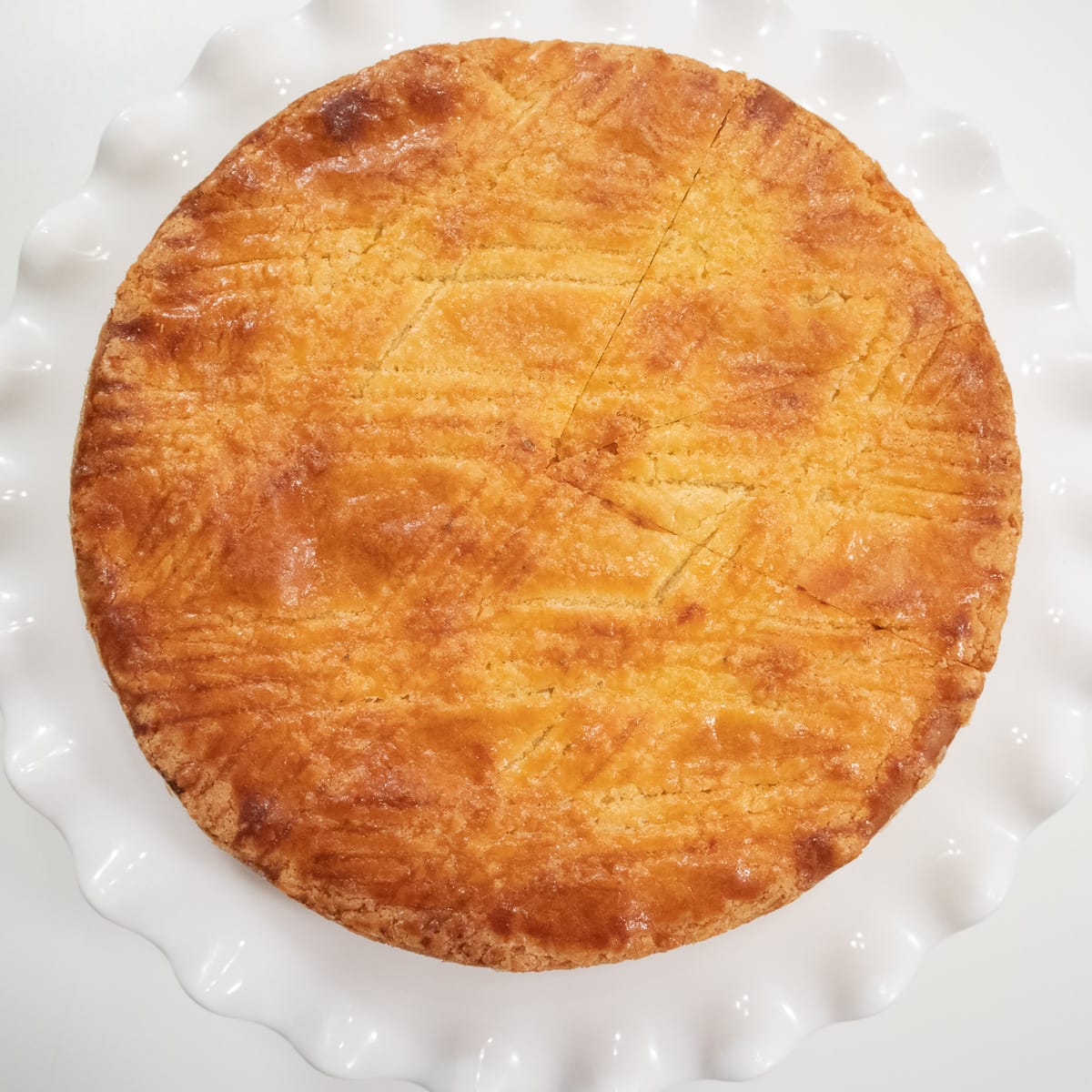
This marvelous French pastry comes from the Brittany region of France; which is known for its butter and sea salt. Interestingly enough, unlike most pastry recipes, salted butter is preferred over unsalted for this recipe, particularly salted European Butter.
Prune Filling
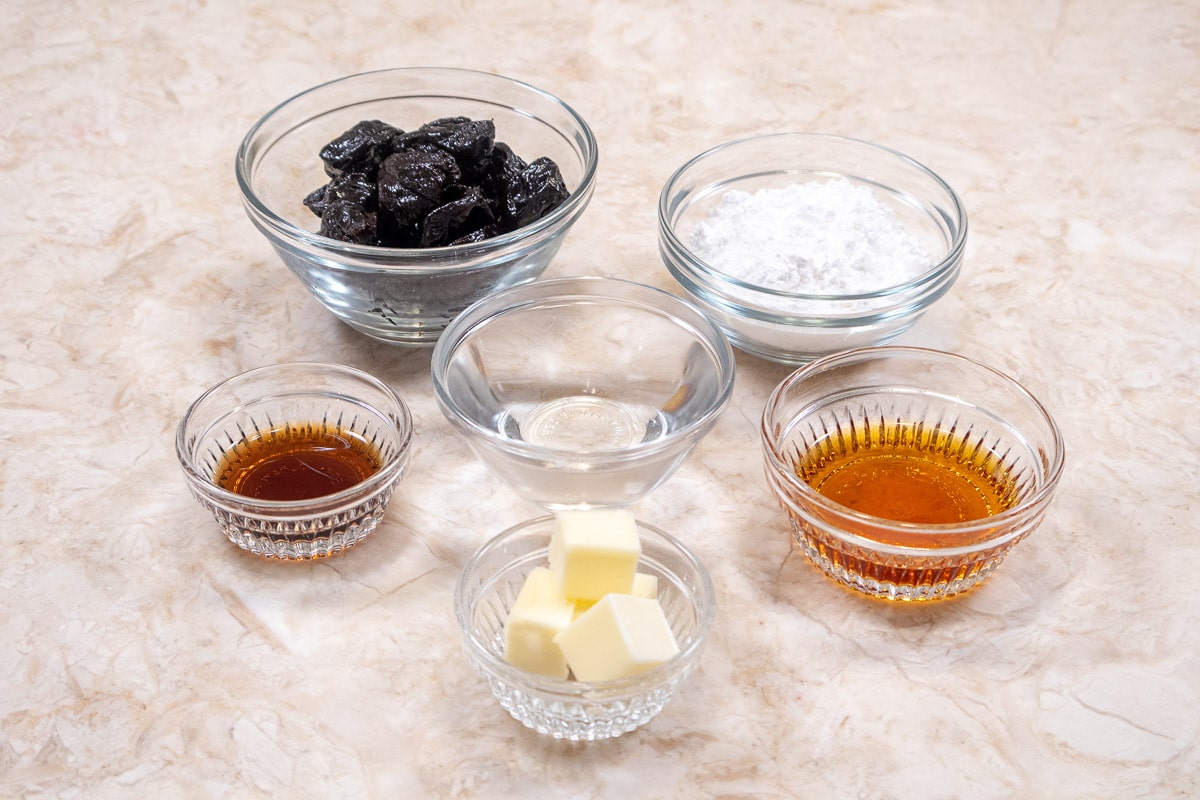
BACK ROW: Prunes, powdered sugar.
MIDDLE ROW : Vanilla, water, dark rum.
FRONT ROW: Butter
Instructions
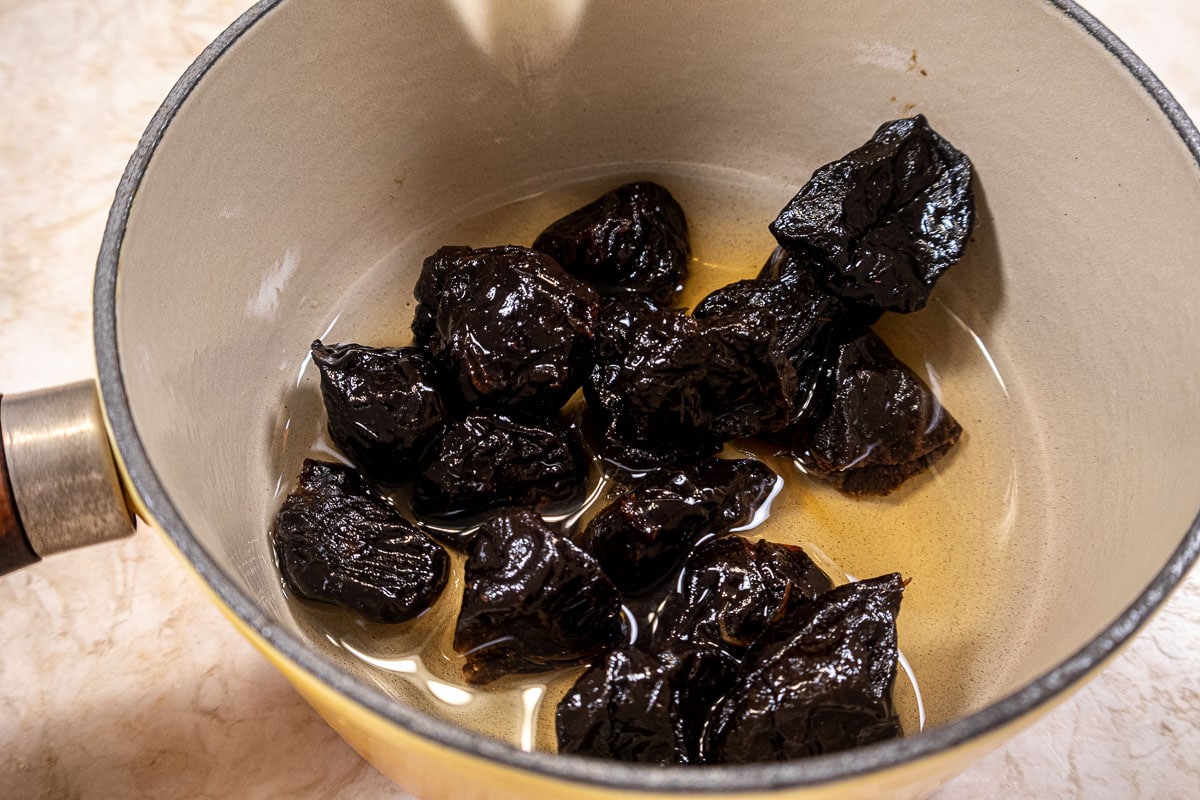
Step 1. The prunes and water are placed in a small saucepan.
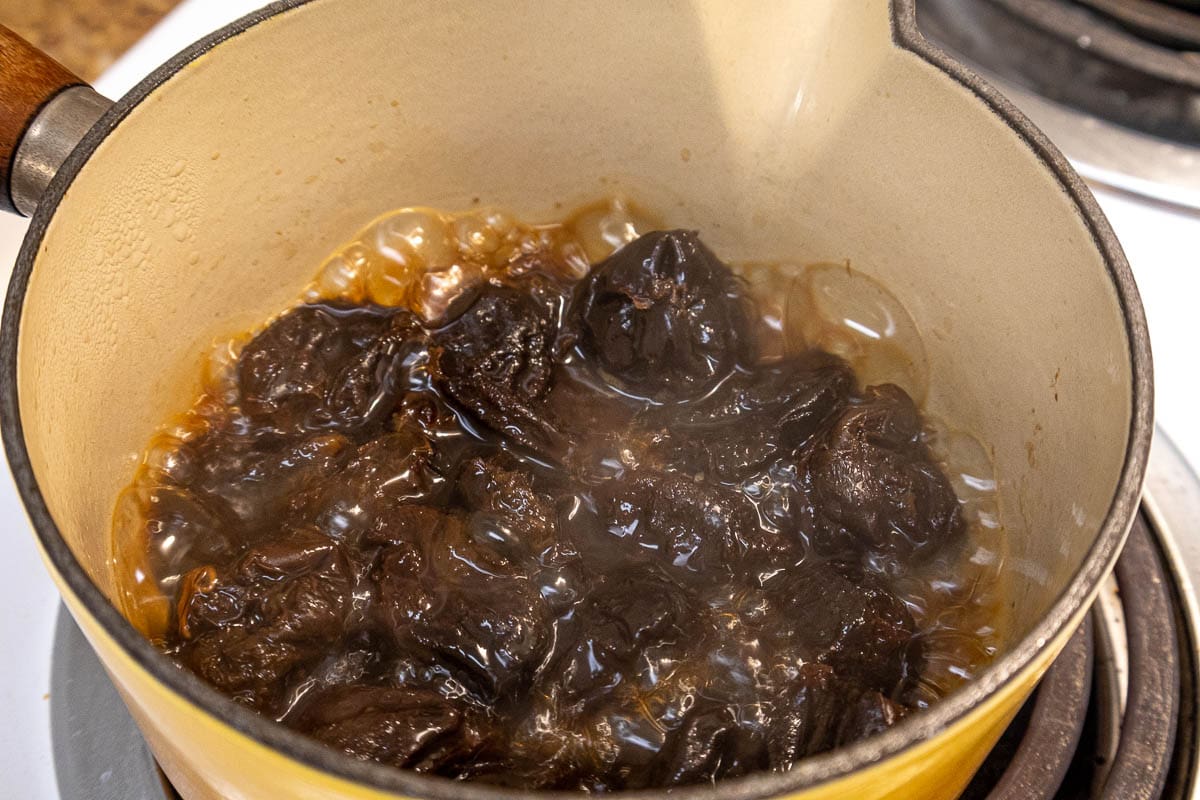
Step 2. Prunes and water boiling.
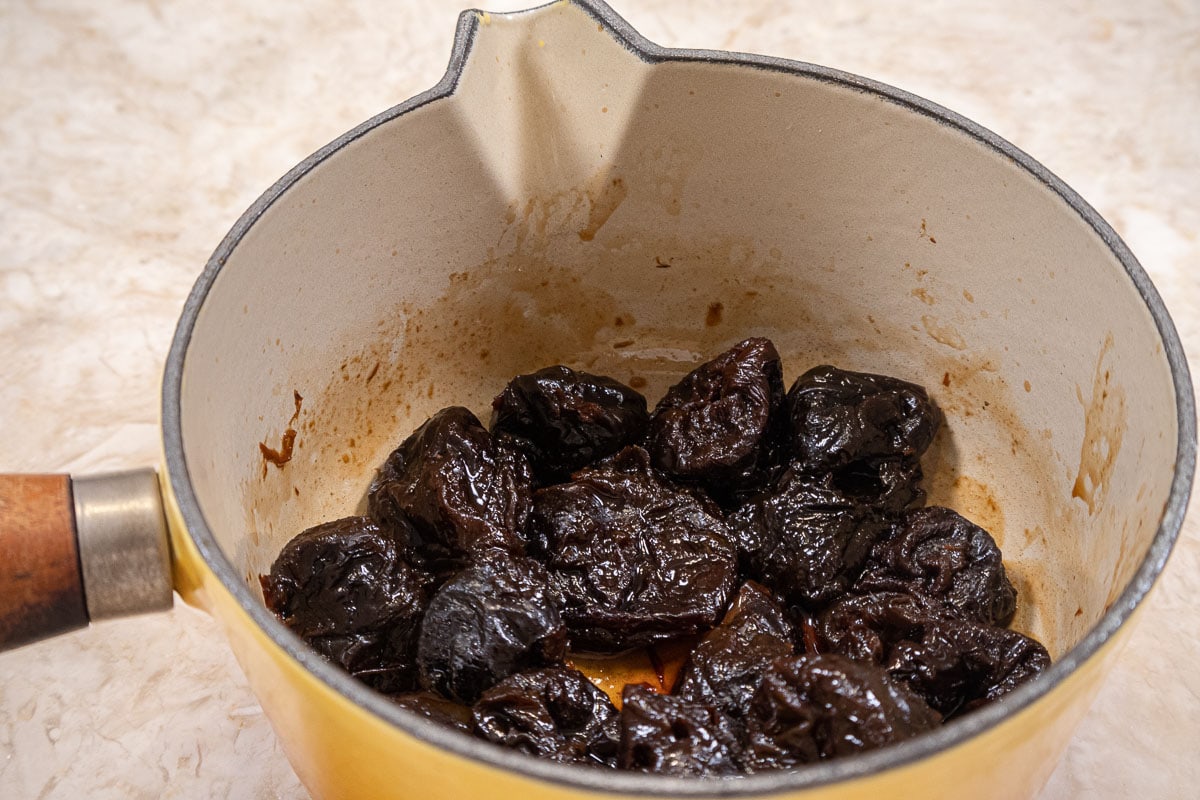
Step 3. The prunes are cooked until just a little water is left in the pan.

Step 4. The prunes are mashed with a fork while they are hot.
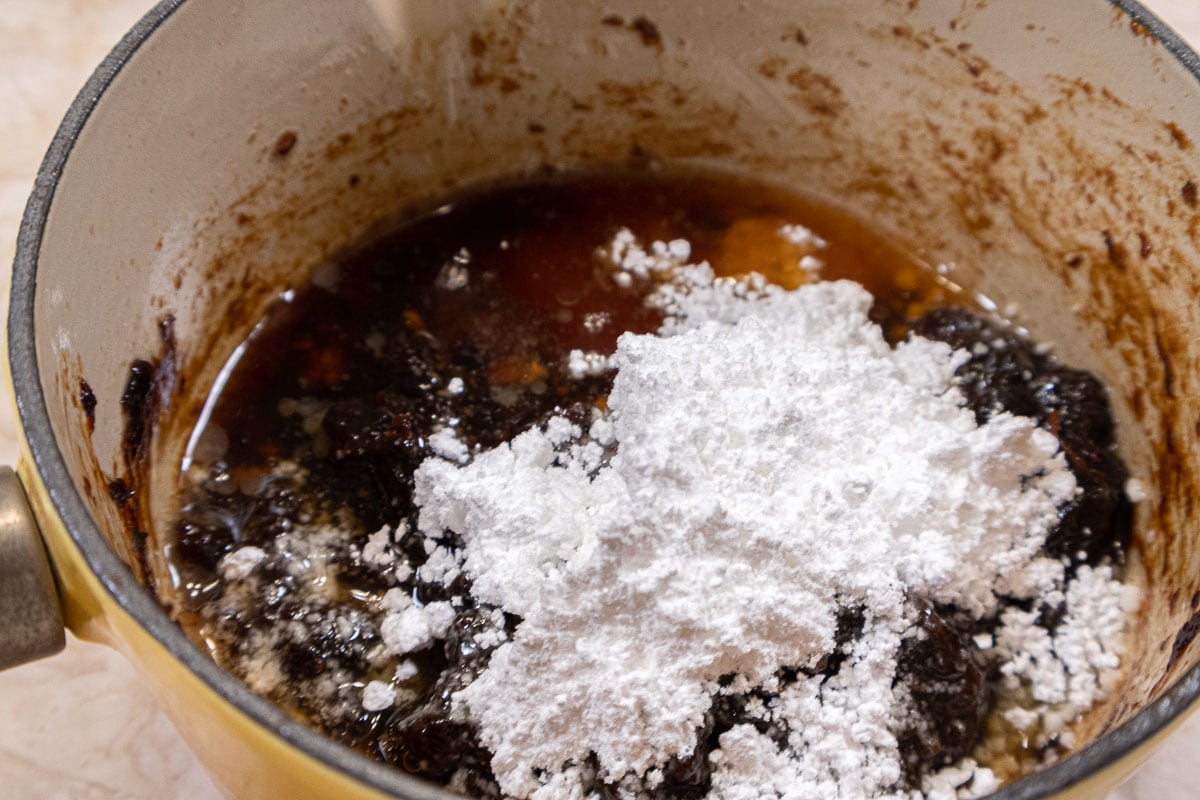
Step 5. The remainder of the filling ingredients are added to the mashed prunes.
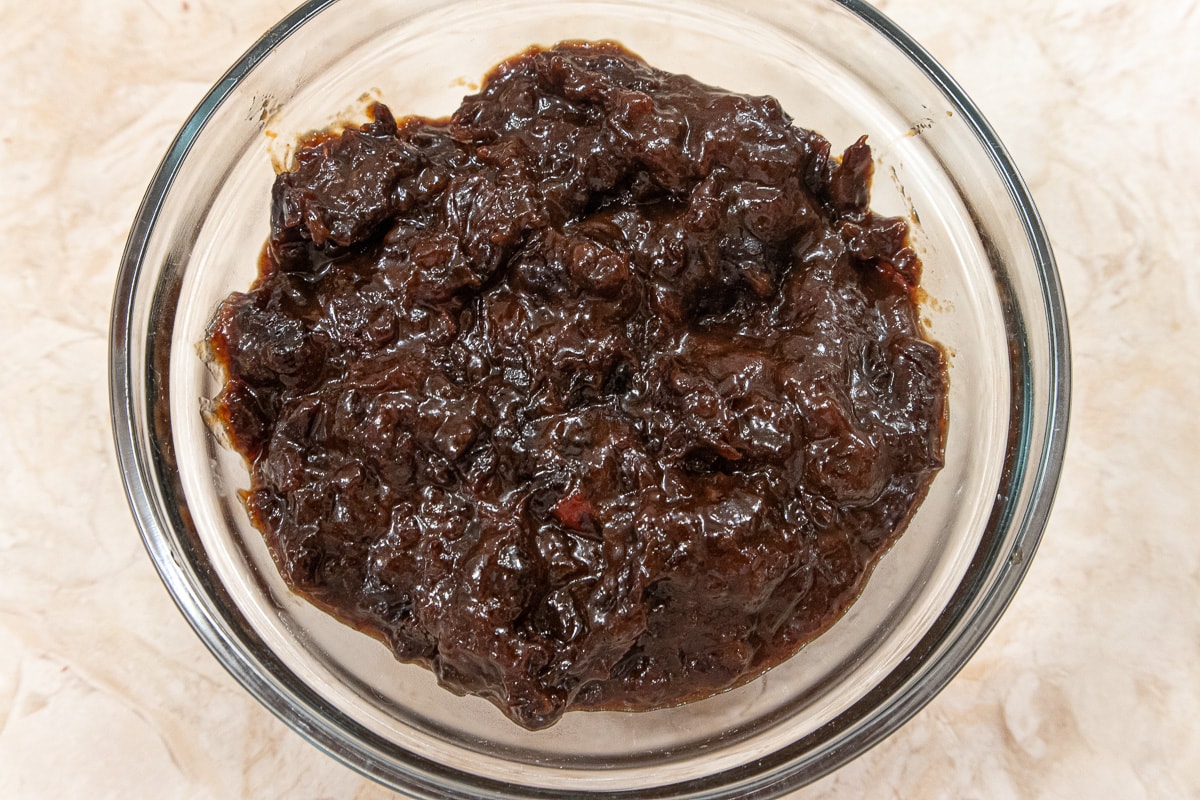
Step 6. The finished filling.
For a complete list of ingredients and amounts please see the recipe card.
Pastry for Gateau Breton
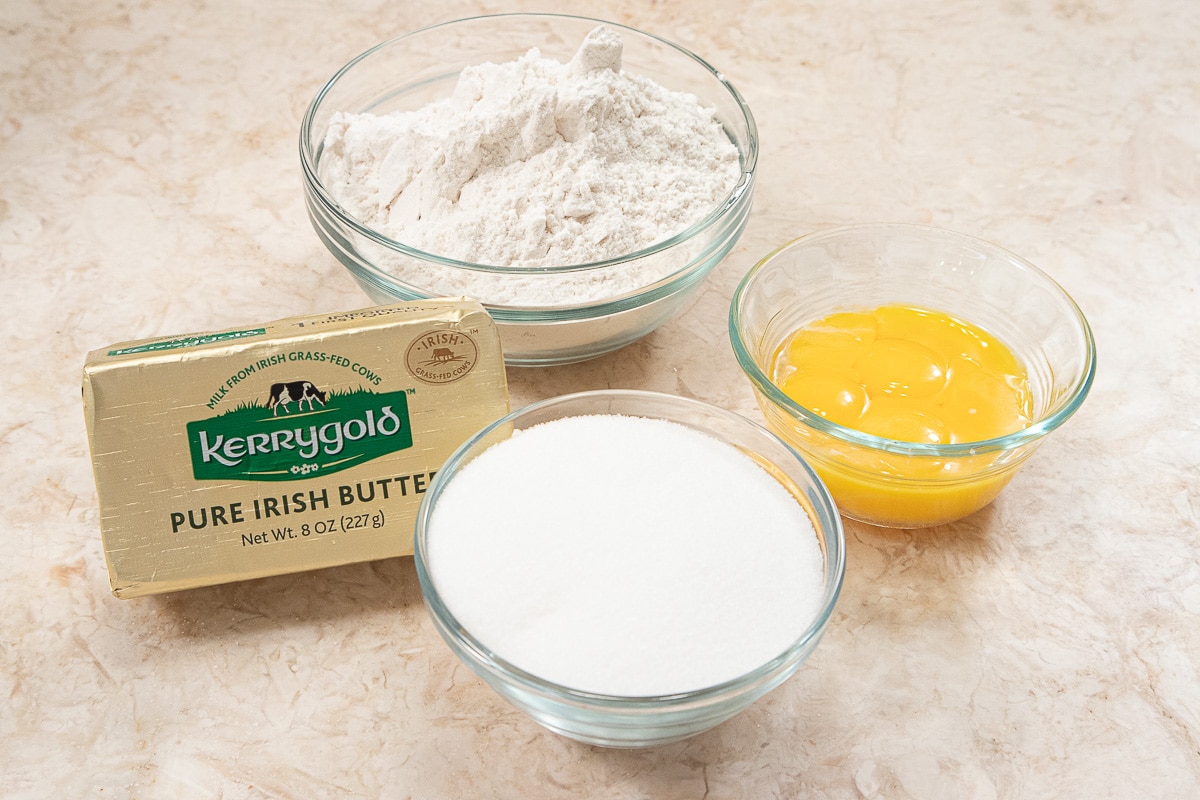
BACK ROW: Flour
MIDDLE ROW: Butter and egg yolks,
FRONT ROW: Sugar
- Salted Butter - European style salted butter is preferred such as Kerrygold or Plugra. It's used for it's higher fat content and it's intense flavor since the pastry is very butter forward.
- Egg yolks - size large are used
For a complete list of ingredients and amounts please see the recipe card.
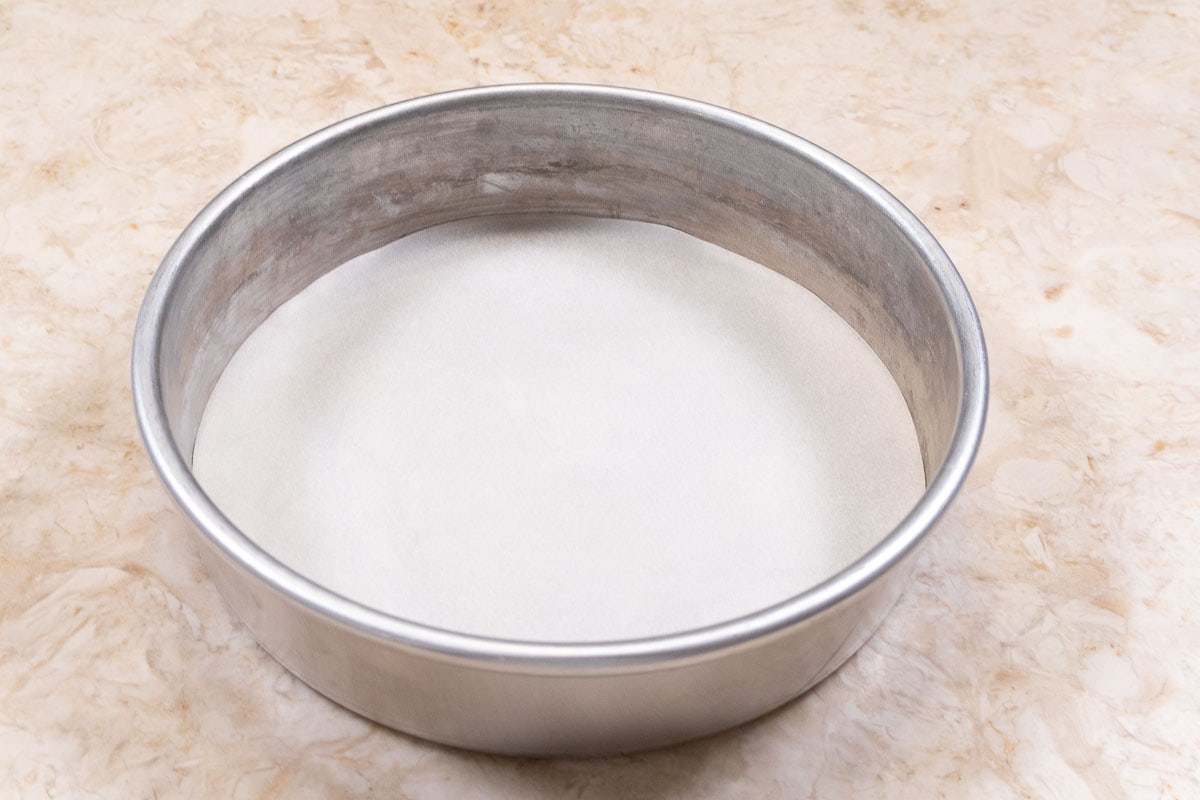
Step 1. Line an 8" round cake pan with parchment paper. Spray the bottom and sides of the pan with a non-stick baking release. Set aside.
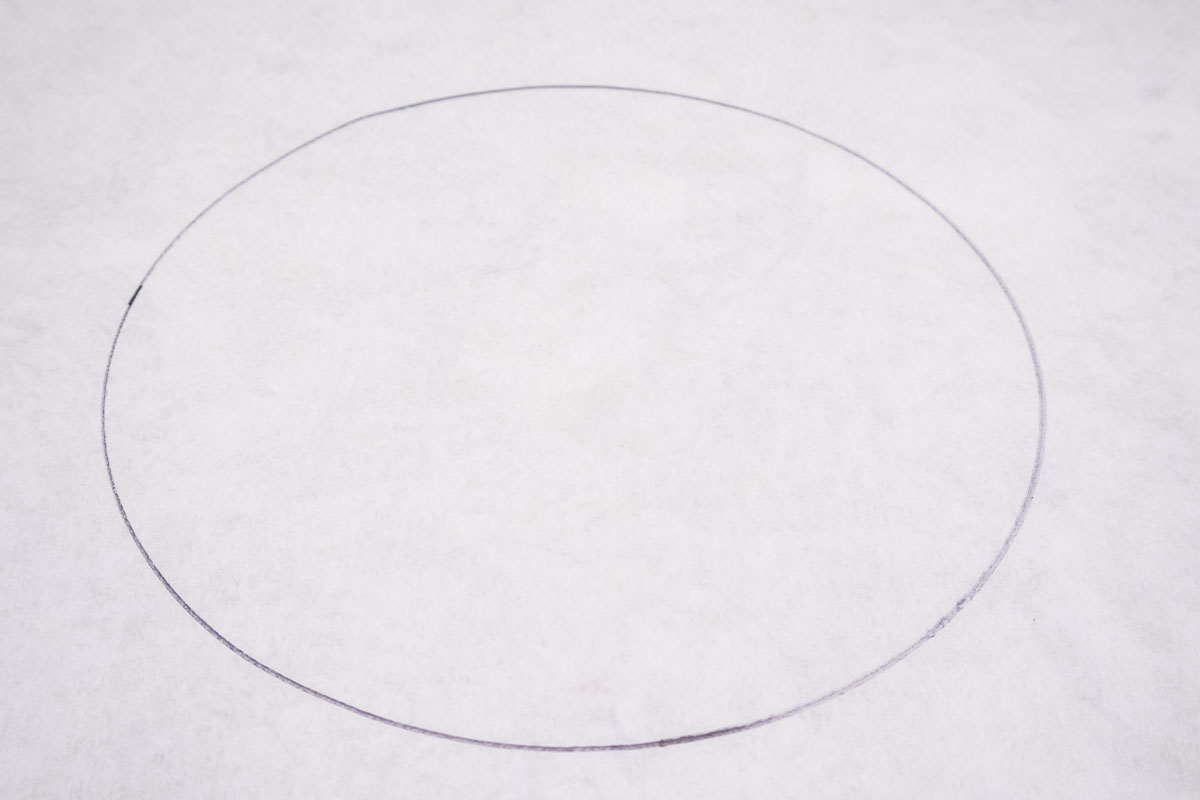
Step 2. Draw an 8" circle on parchment paper. Turn it upside down and set it aside. Preheat the oven to 350°F.
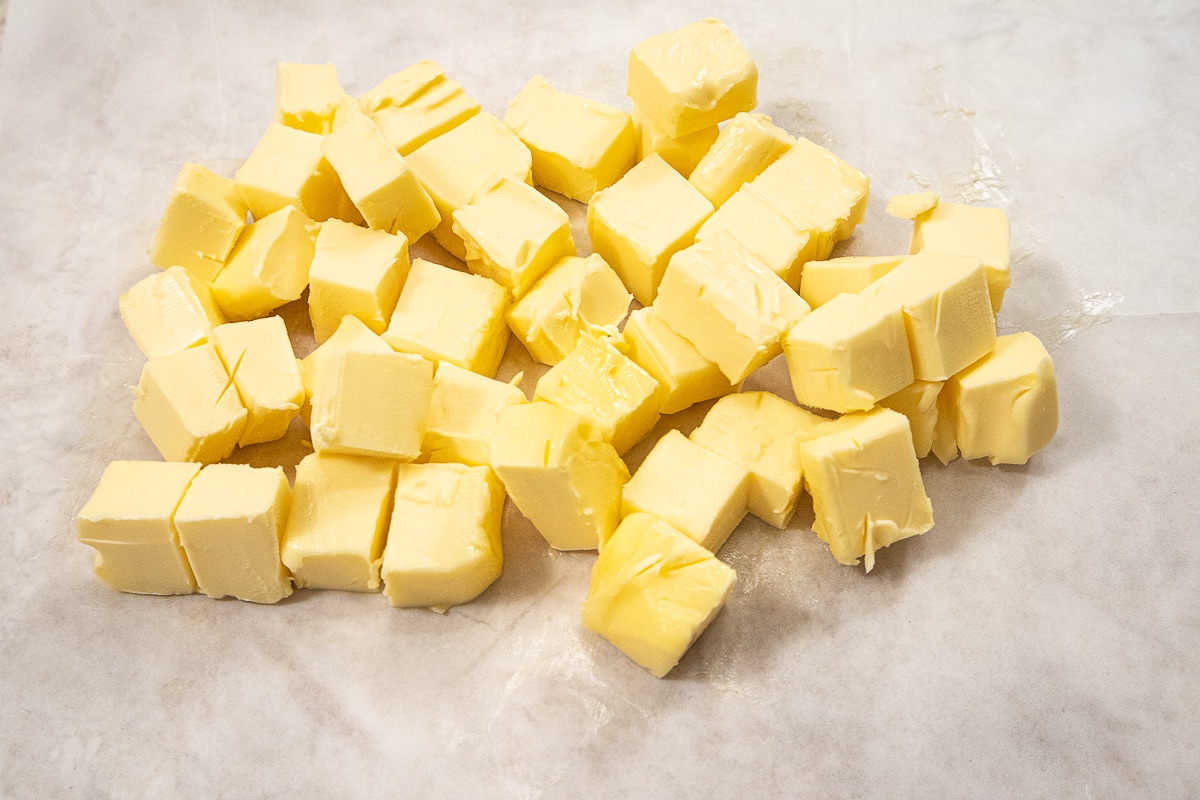
Step 3. Cut butter in small pieces and keep refrigerated until needed.
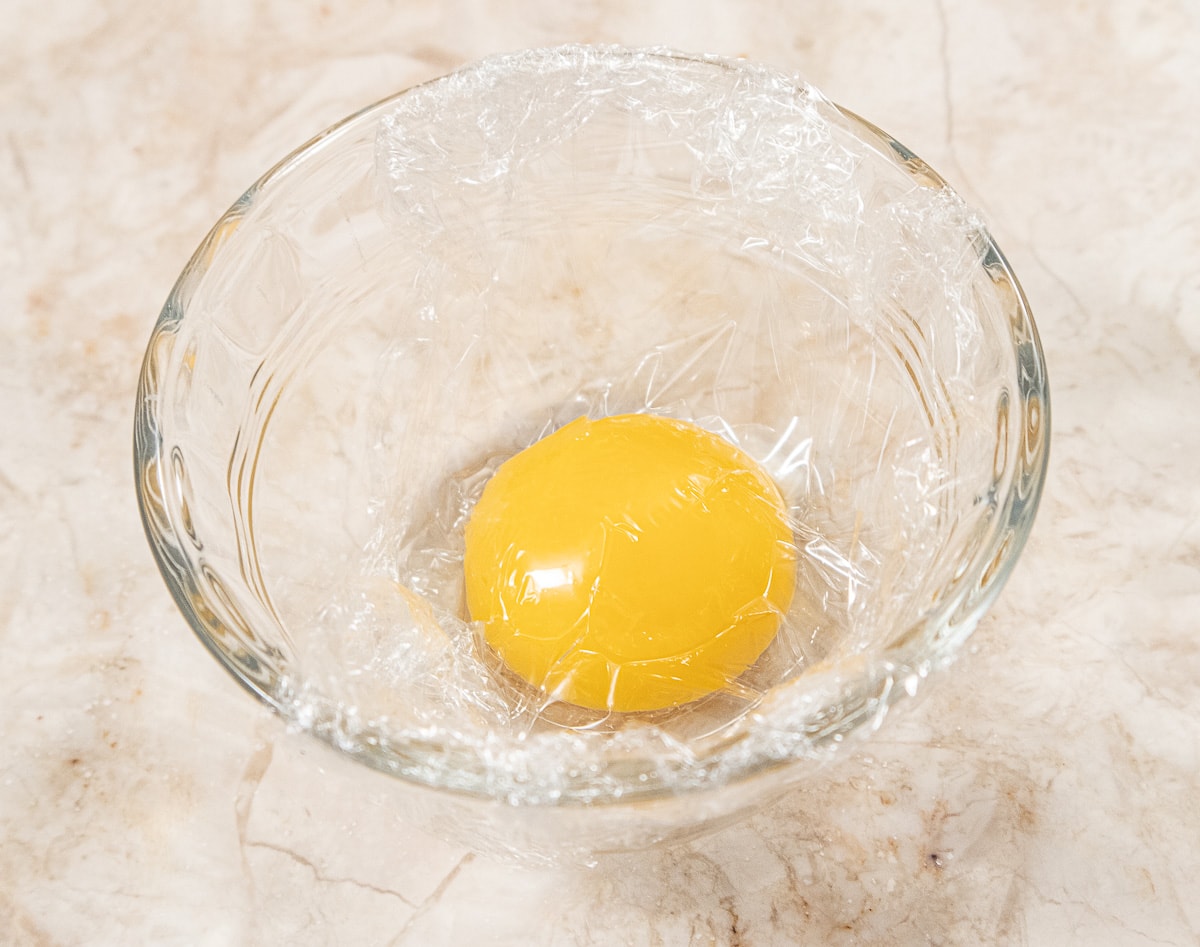
Step 4. Reserve one egg yolk, covered and refrigerated.
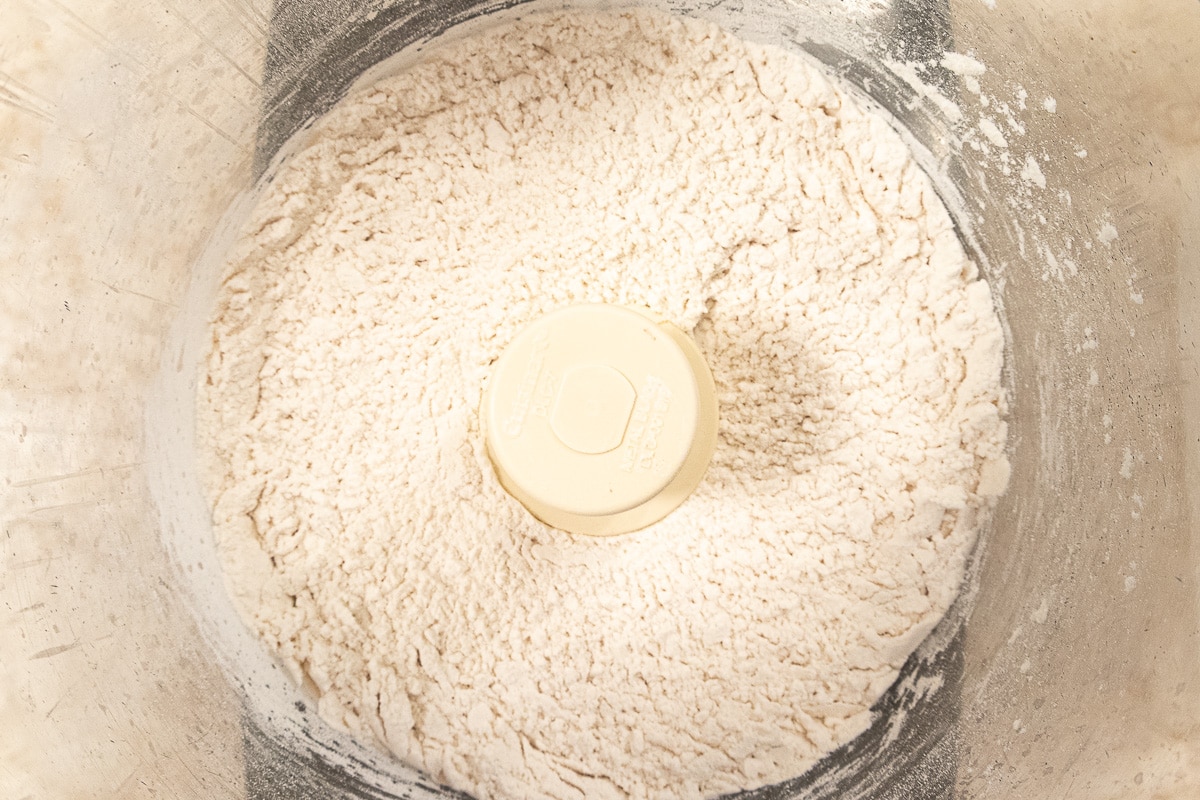
Step 5. Place the flour and sugar in the bowl of the processor. Pulse several times to mix.
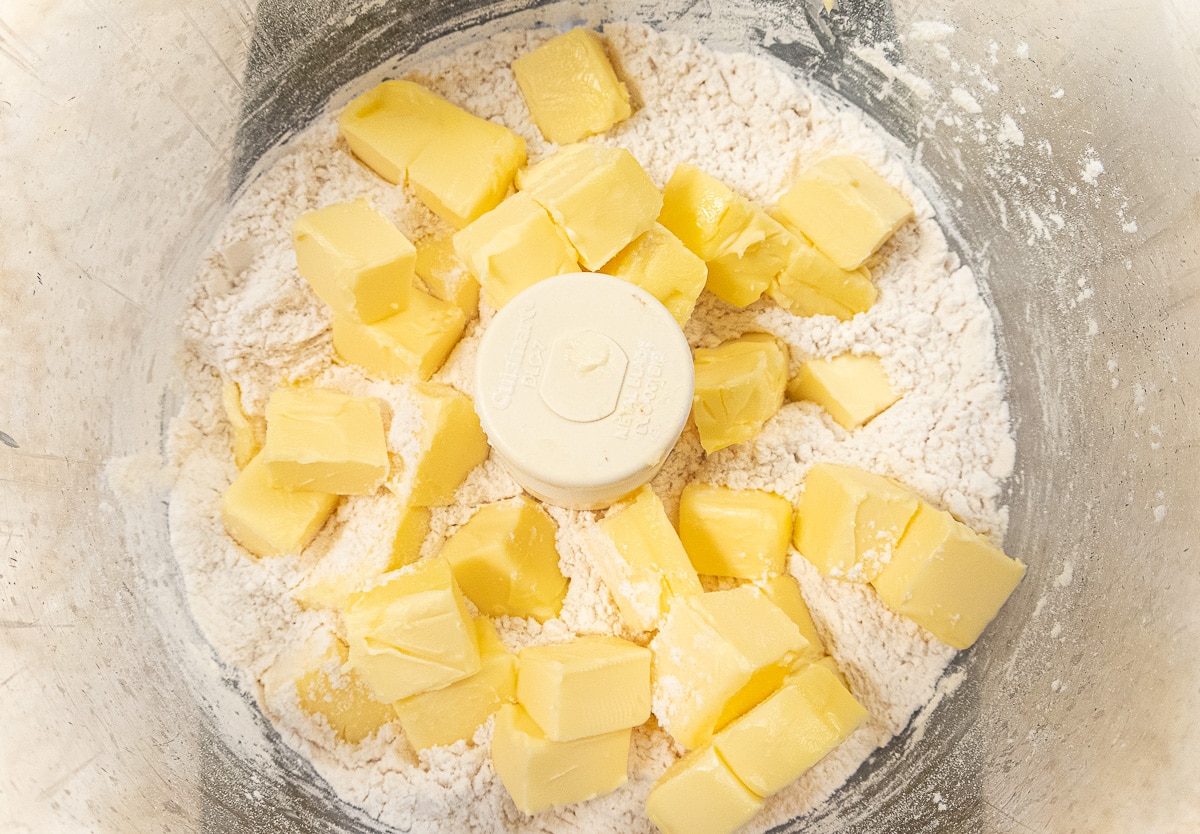
Step 6. Refrigerated butter is added to the processor.
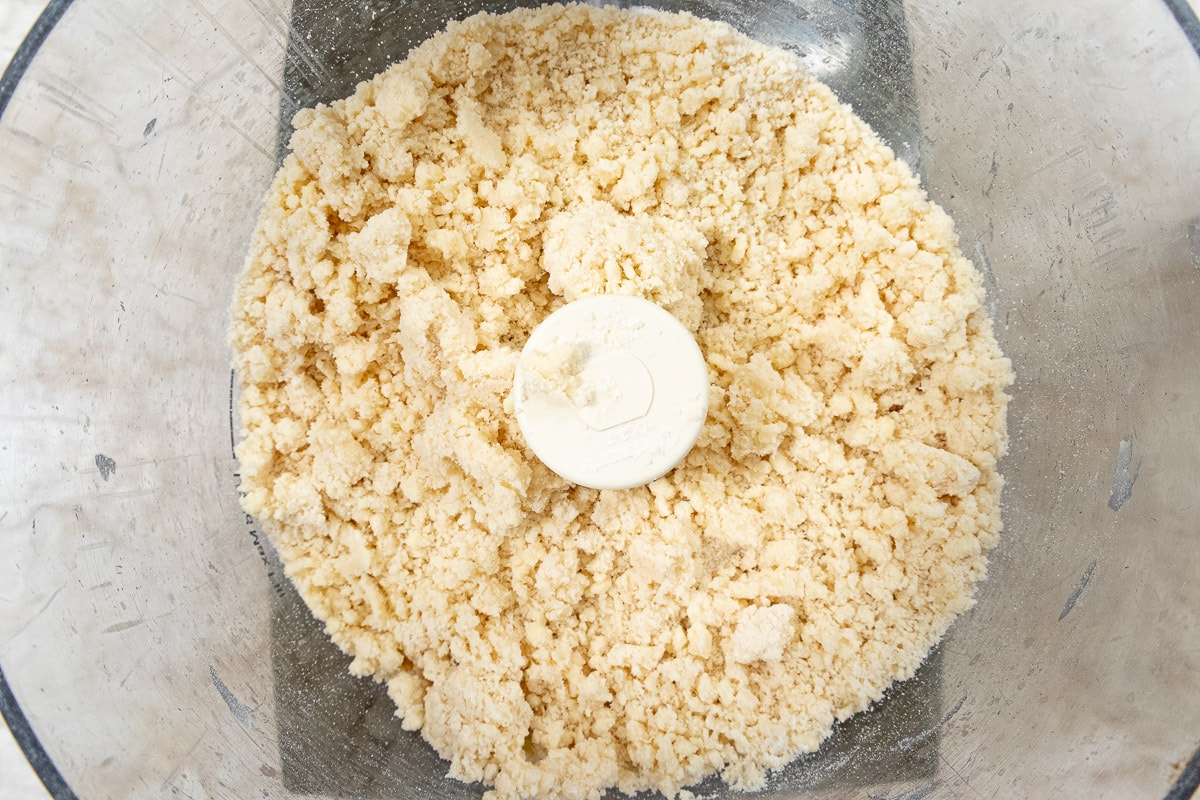
Step 7. The butter is processed until it is indistinguisable. Do not let it form a ball.
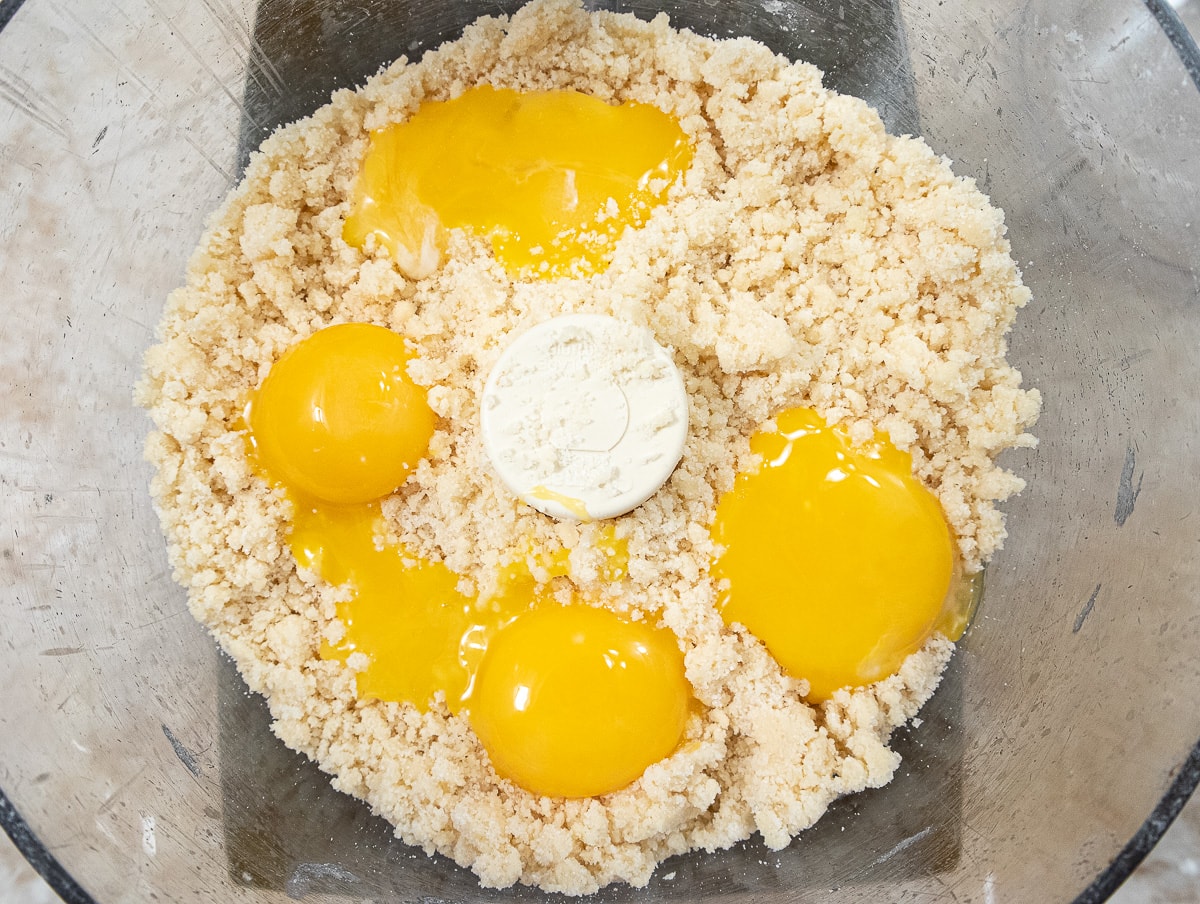
Step 8. Five eggs are added to the processor.
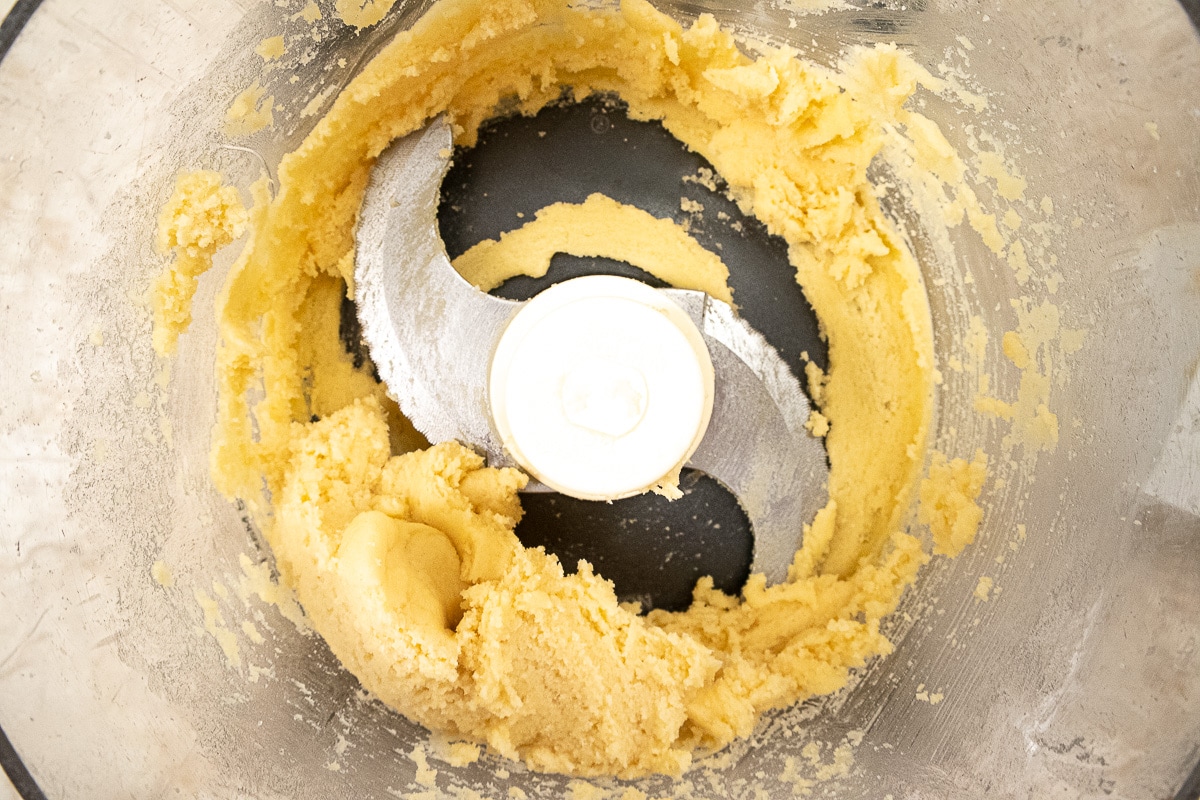
Step 9. The pastry for the Gateau Breton is processed to mix completely. Be sure to scrape down and rearrange as needed until it comes together. Remove from the processor.
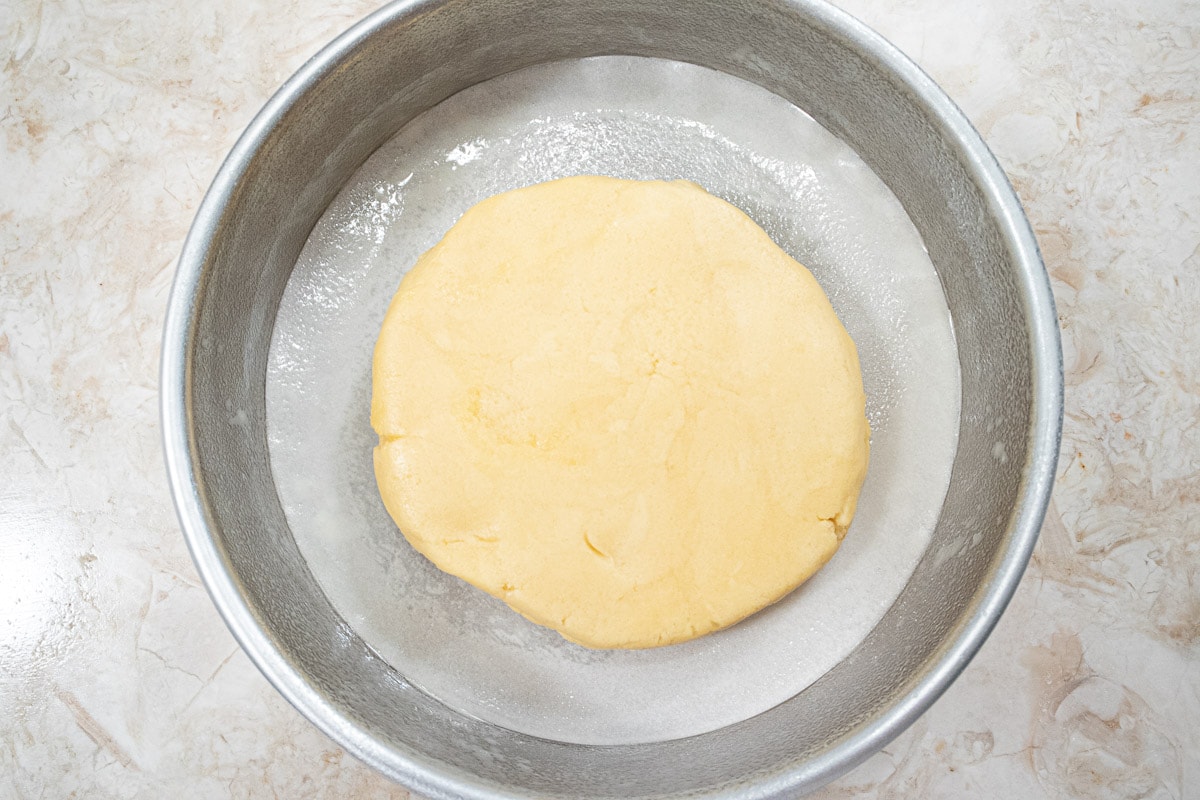
Step 10. Divide the dough in half and shape each half into a disc. Place one disc in the bottom of the pan. If it is too soft, refrigerate briefly to firm it up slightly.
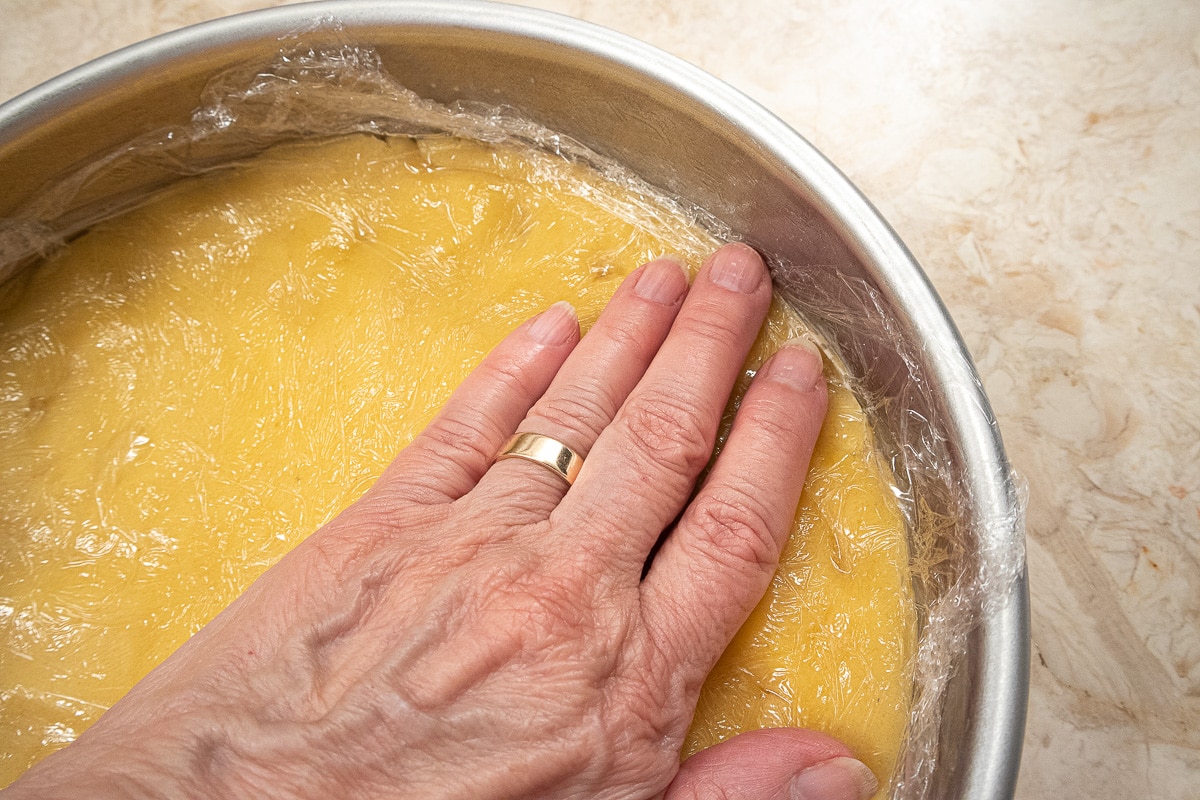
Step 11. Cover the disc with plastic wrap and press the dough evenly into the bottom of the pan. Remove the plastic wrap.
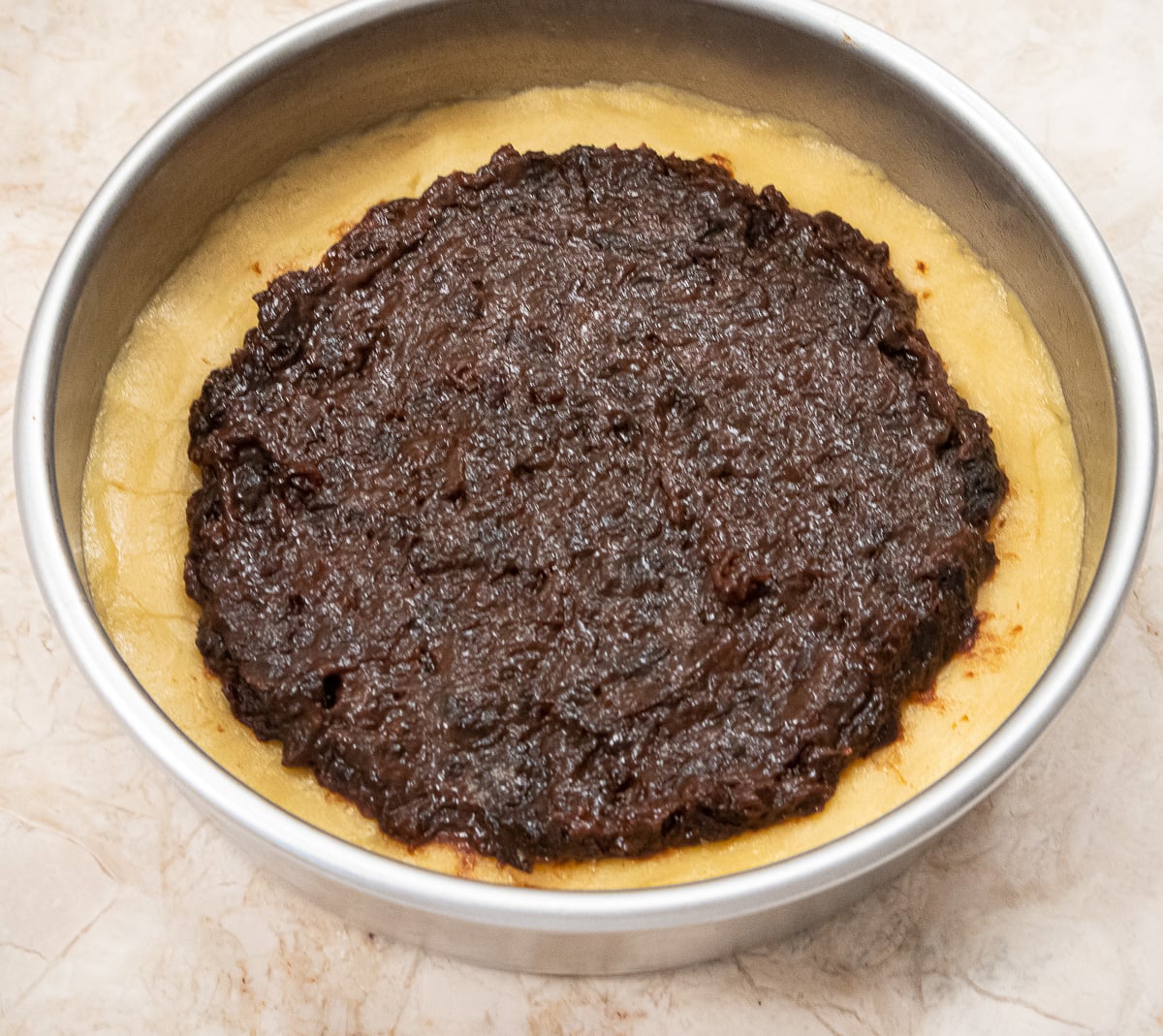
Step 12. Spread the filling to within ¾" of the edge of the pastry.
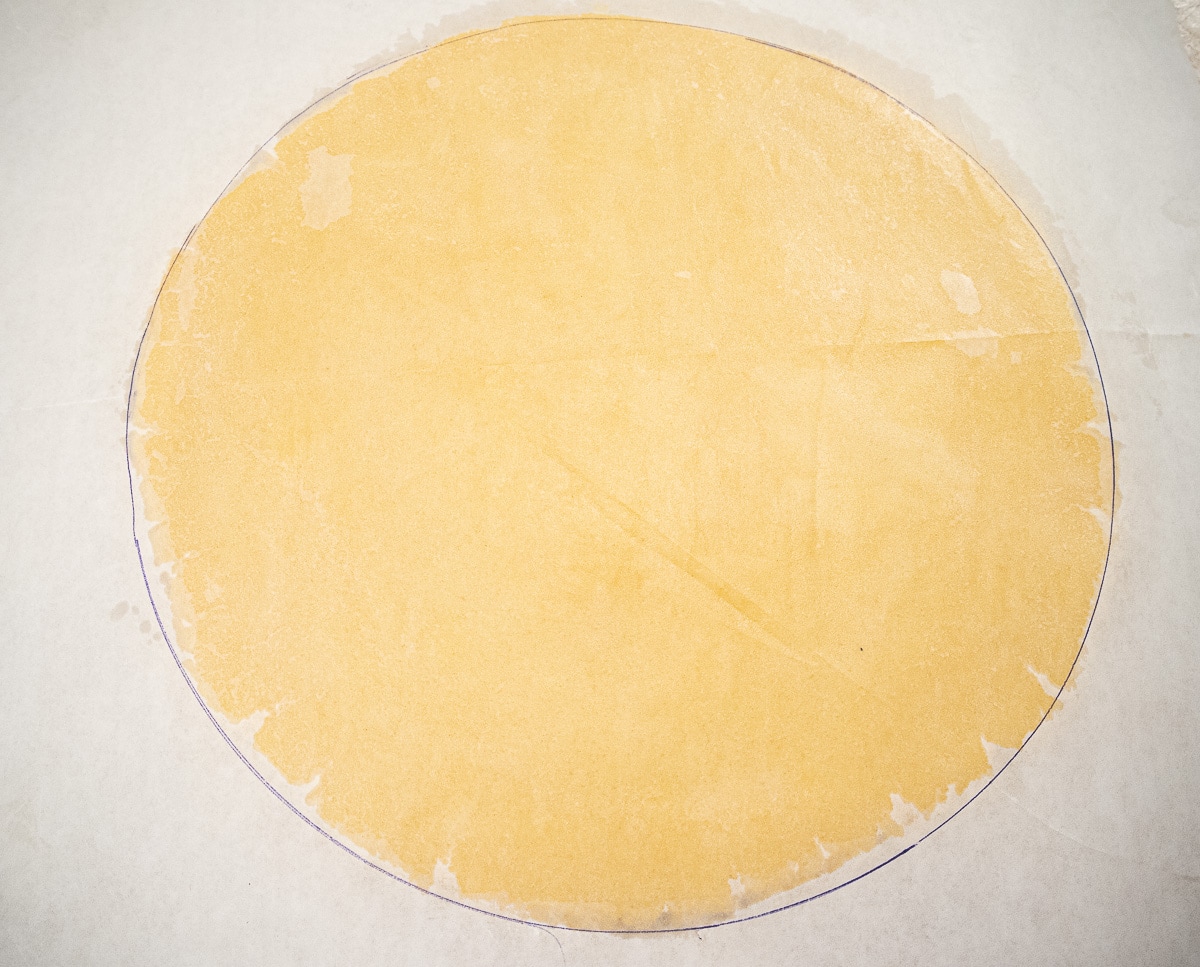
Step 13. Place the second half of the pastry in the middle of the circle drawn on the parchment paper. Place parchment paper or wax paper over the pastry and roll it out to fit the circle. Flip the paper over so the bottom is on top and refrigerate until firm but not hard.
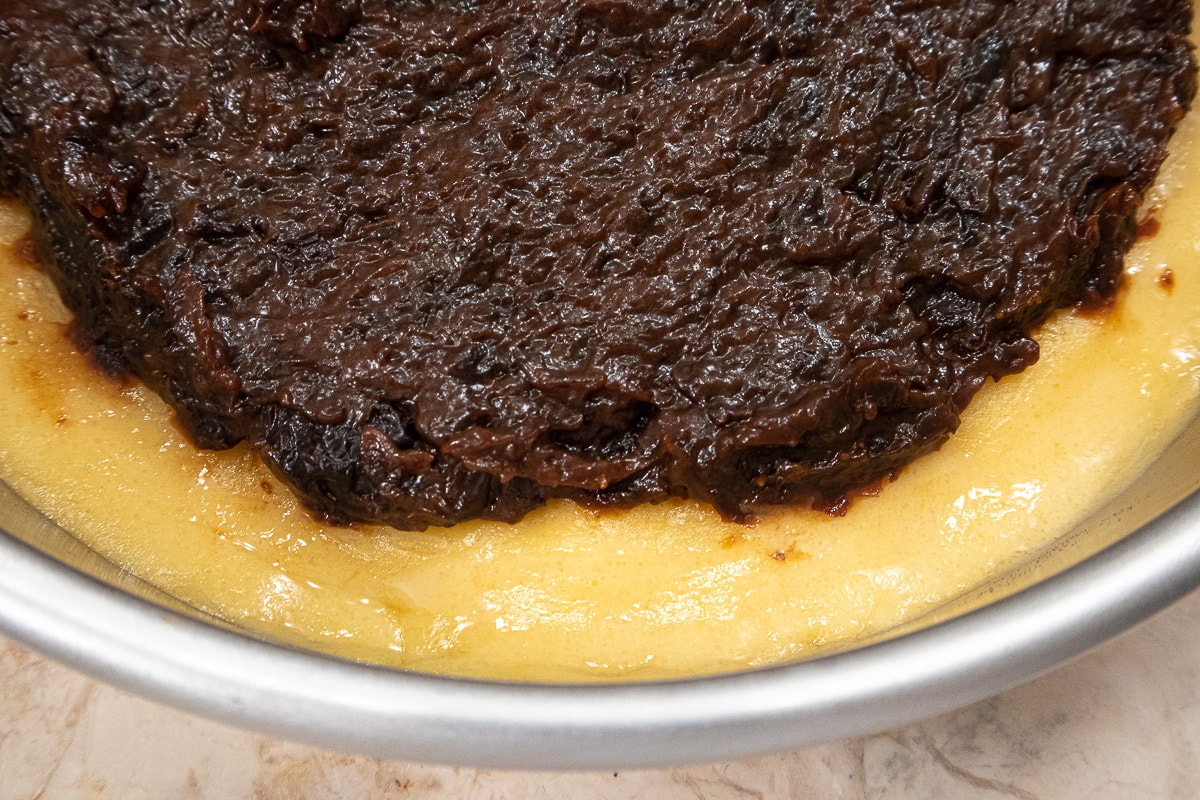
Step 14. Moisten the edge of the pastry with water.
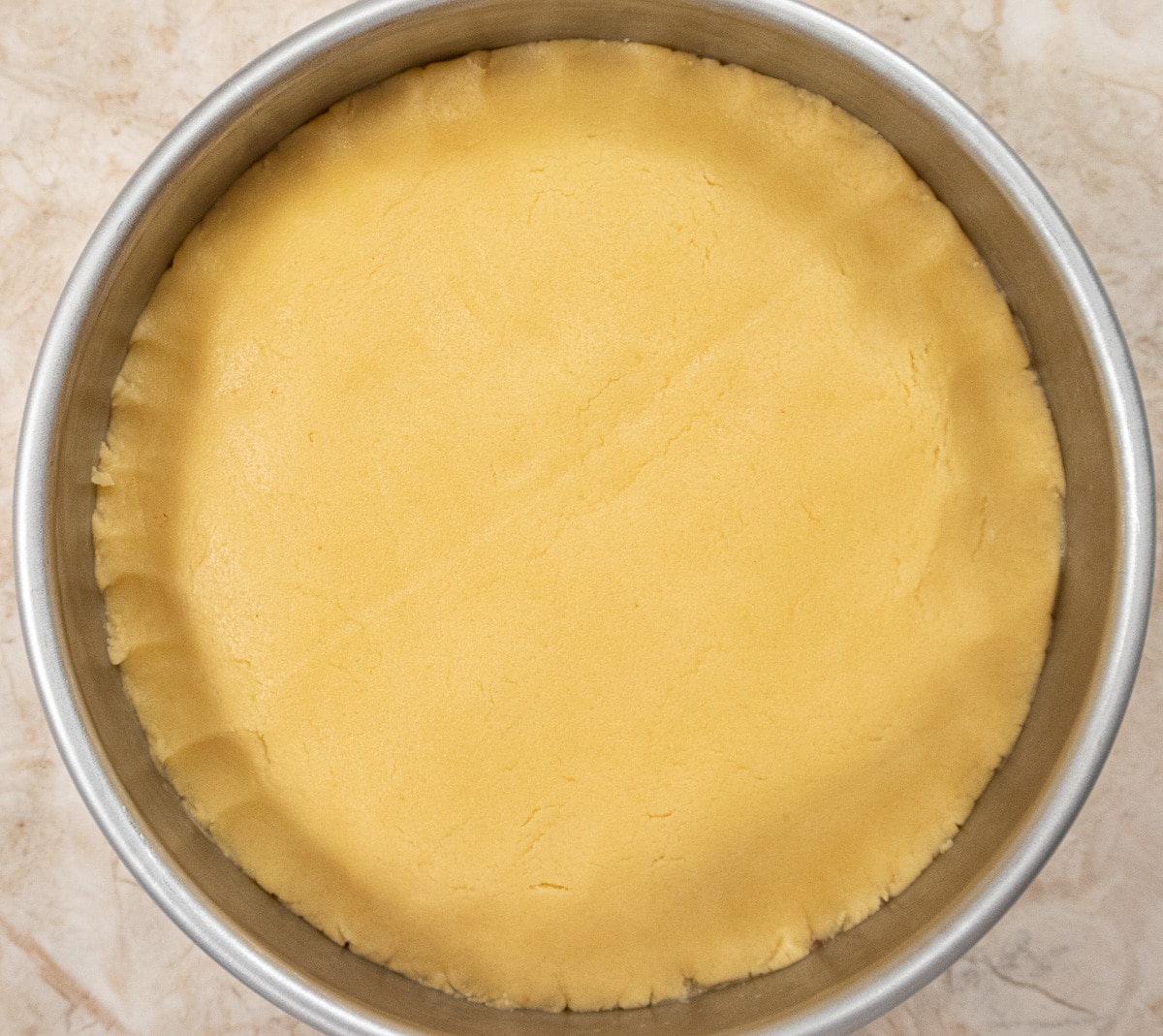
Step 15. Place the top crust over the filling. The edges of the top and bottom are pressed together. Make a cross hatch design on the top and brush with the egg wash.
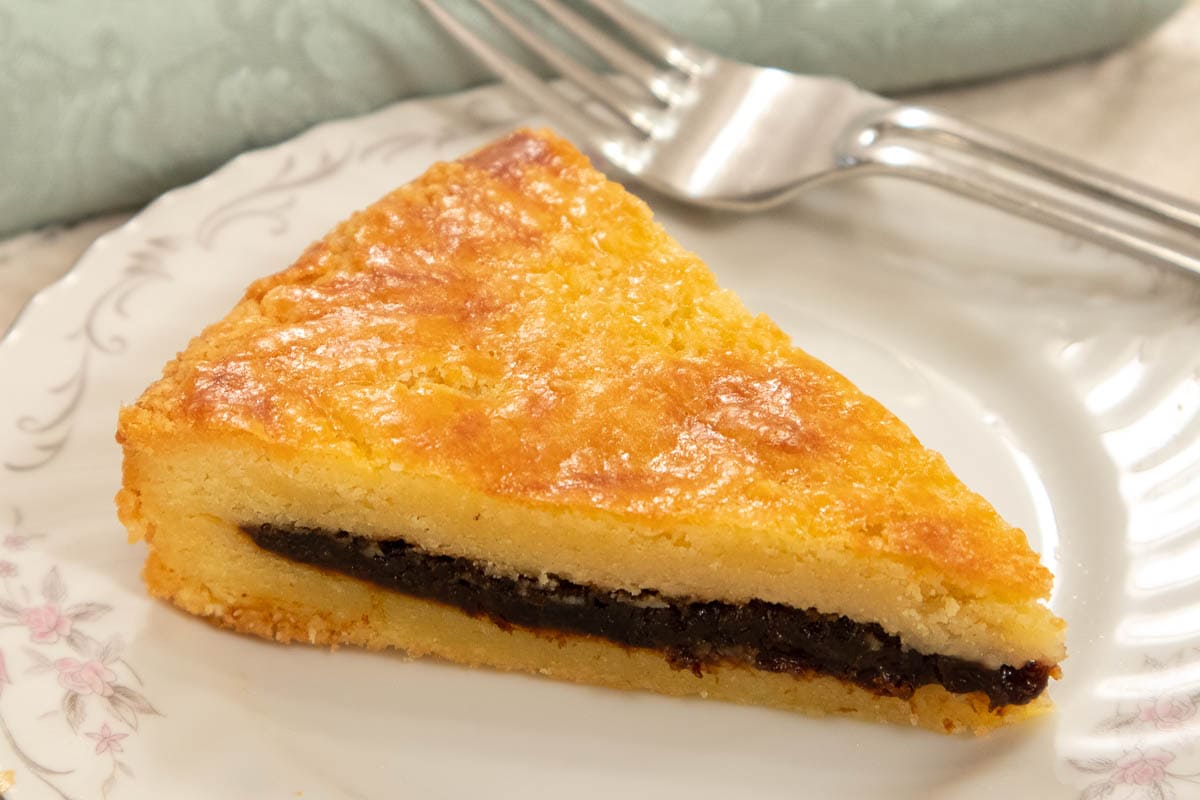
Step 16. Bake the Gateau Breton for 50 to 55 minutes until the top is a medium brown. Cover loosely with foil if it is browning too quickly. Cool to lukewarm. Go around the edges of the pan with a small metal spatula and turn out. Cool completely on a rack.
NOTE: If the pastry is very soft coming from the processor, chill it just until firm enough to press in and roll out. Do not let it get completely hard or the large amount of butter in the pastry will make it difficult to roll out.
Variation
- Substitute dried apricot for the prunes if desired.
Storage
The pastry will keep for at least 5 days at room temperature if kept covered.
Gateau Breton
Ingredients
Prune Filling
- 4 ounces dried prunes
- ⅓ cup water
- 2 tablespoons dark rum
- 1 tablespoon butter, cut into several small pieces (15 grams or ½ ounce)
- ¼ cup powdered sugar
- 1 teaspoon vanilla
Gateau Breton Pastry
- 1 cup salted European style butter, cold (225 grams or 8 ounces)
- 6 large egg yolks
- 2 cups all-purpose flour (280 grams or 10 ounces)
- 1 cup granulated sugar (200 grams or 7 ounces)
Instructions
Prune Filling
- Place the prunes, water and dark rum in a small pan. Bring it to a boil and cook until most of the water has evaporated.
- Remove it from the heat and mash the prunes with the back of a spoon until smooth. Don’t worry if a few small pieces are left.
- And the remaining ingredients, stirring until the butter melts and all is combined. Set aside to cool completely.
Gateau Breton Pastry
- Line an 8” round cake pan with parchment paper. Spray the paper and entire cake pan with a non-stick baking release. Set aside.
- Using the round pan, draw an 8” circle in the middle of a piece of parchment paper. Turn it over and set aside. Preheat the oven to 350F.
- Cut the butter into small pieces and keep refrigerated until using.
- Reserve one egg yolk for the finish. Place it in a small bowl and cover it directly with plastic wrap.
- Combine the flour and sugar in the bowl of a food processor. Pulse to combine.
- Add the cold butter and process until it is indistinguishable.
- Add five egg yolks and process until the dough comes together. Scrape down.
- Rearrange the dough in the processor as needed so it comes together
- Remove the dough from the processor.
- Clean the blade by pulsing several times.
- Bring the dough together in one piece. It will be soft at this point. Do not add flour to the work surface. Just use a gentle motion to bring it together. It will weigh about 770 grams or about 27 ounces. Divide it in half or about 385 grams each or 13 ½ ounces each. Shape into discs.
- If the dough is too soft to work, chill it for about 2 hours or so until it firms up. Do not let it get too hard or it will be difficult to press in and roll out.
- Place one disc in the middle of the pan. Cover it with plastic wrap and press it out evenly to cover the bottom of the pan.
- Spread the filling to within about ¾ inch from the sides.
- Place the second disc of pastry in the middle of the circle on the parchment paper. Place another piece of parchment or waxed paper over the pastry and roll out to fit within the 8” circle.
- Flip the paper over so the bottom is on top. If the pastry does not exactly fit, adjust it now.
- Chill just until firm but not hard, about 10 to 15 minutes.
- In the meantime, stir a teaspoon of water into the reserved egg yolk.
- Dampen the edges of the bottom piece of pastry with water and place the top over the filling. Press the top and bottom edges together lightly.
- Apply the egg wash to the top of the cake. Using a fork, draw a cross hatch on the top layer.
- Bake for 50 to 55 minutes until the top is a medium brown. Cover with foil if it browns too quickly.
- Cool to lukewarm, go around the edges of the pan with a small metal spatula and turn the gateau out. Cool completely right side up.


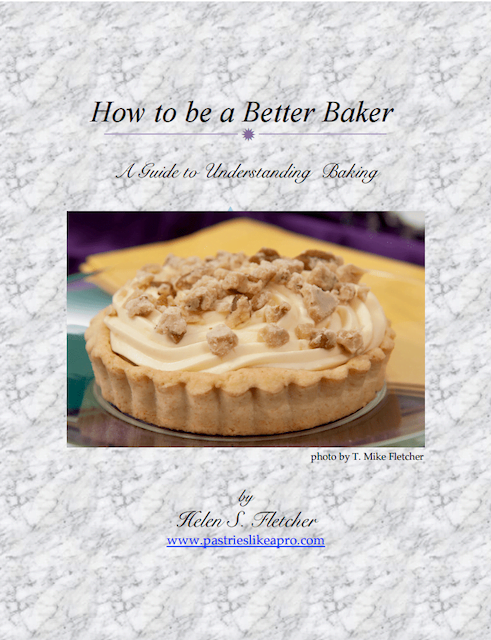
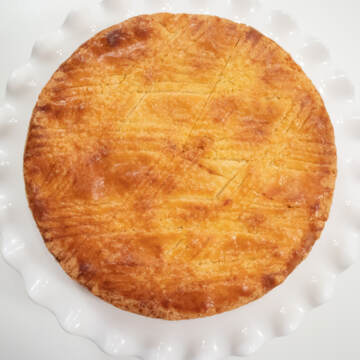

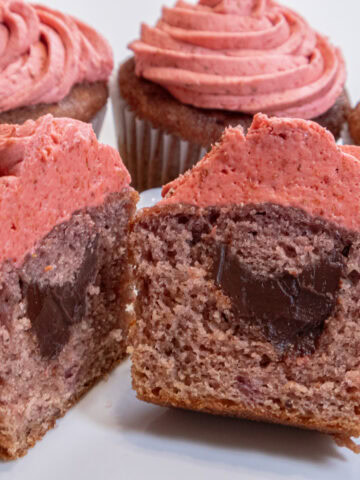

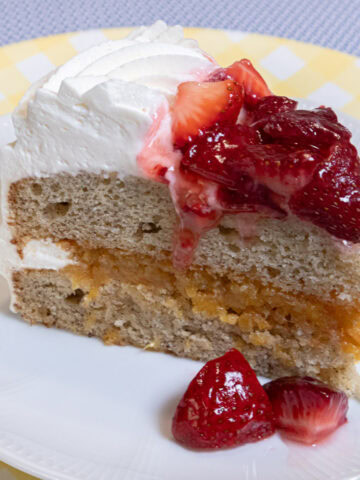
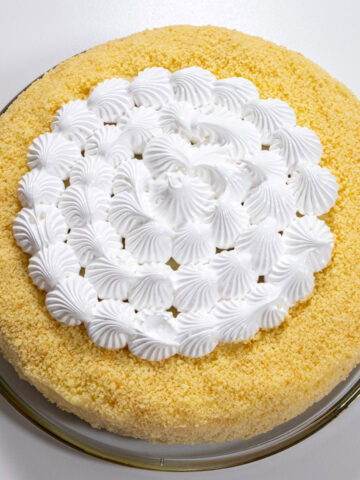
Mark says
Hi Helen,
I’ve made the Gâteau Breton with prune and apricot and looked at these pastry fillings. In a week I’m leaving to visit family in Europe until the end of April. “Finish it up Week” begins in earnest tomorrow. As part of my Olympic Refrigerator Emptying trials, I must find creative uses for some of the Bonne Maman Quatres Fruits preserves. If I were to use them for a Gâteau Breton filling, should I reduce them on the stove or in a microwave to avoid a runny filling? Add corn or potato starch? Hope not. Thanks for any suggestions.
Helen S Fletcher says
They are preserves. Leave the in the fridge or are you shutting down the fridge? I would not attempt to alter them for the filling for a Gateau Breton. Concentrating them will alter the flavor and trying to add starch is iffy. Depending upon how much you have, I'd suggest using them on biscuits, scones or toast. Probably not what you want to hear. Enjoy your trip and your family.
Denise says
As I prepare to make this, I noticed the pan size is 9” in the steps, but 8” in the recipe. Which size do you recommend?
Helen S Fletcher says
Hi Denise - it should be an 8" round cake pan. I corrected the recipe. Thanks for calling my attention to this.
Denise says
Helen, It turned out delicious. I made it with dried apricots as recommended and it tastes wonderful with the other flavors. I appreciate your tip on using European butter. Thank you!
Helen S Fletcher says
So happy to hear Denise. It's one of my favs for sure.
Fed says
Haven't tasted it yet but it looks amazing and was very easy to make with the recipe. The rolling out top pastry step made it simple to assemble. The only thing I couldn't find was the baking temperature, I guessed standard 180°C and it looks like that worked.
Helen S Fletcher says
Thank you so much for this. I read, and reread but sometimes you just go right over one of the most important parts. So happy though that the directions and photos worked out for you.
Helen S Fletcher says
I read and re-read but I apparently I skipped one of the most important directions. You are correct 350°F/180°C is the temperature. So happy the directions and photos helped you make a perfect Gateau Breton. Thanks so much for letting me know so I could get this into the directions.
Susan Brooks says
Hello Helen -
This, like all your recipes, looks fabulous. I do have a problem with receiving your blog - it always goes to my junk mail, no matter how many times I have tried to re-subscribe. Am I missing something?
Hope somebody can help me.
Cheers,
Susan
Helen S Fletcher says
Hi Susan, so much for tomorrow. I went in and did a manual subscribe of your name and email address. Let me know if this works. If not we'll try something else.
Cat says
Oh, this is PERFECT timing for our Canadian Thanksgiving this weekend! I've been fishing around for a special dish, Helen, and I think this looks just right. And, as always, your clear and precise instructions combined with endlessly helpful photos of the process along the way means I'm ok with tackling a new recipe with company coming. Thank you!
Helen S Fletcher says
Hi Cat, Well this just makes my day. So happy one of my desserts will grace your table this weekend. Happy Thanksgiving and thank you.
Rocky says
Mmm I love this and have not had it in a long time. My husband does not like dried fruit of any kind, especially prunes. If I make it for myself you know I will eat the whole thing. So its best to make it for company right? What other fillings have you made this with?
It looks fabulous. Thank you as always.
Xo
Helen S Fletcher says
Hi Rocky - I've only made it with prunes but dried apricots can be substituted. Also, I've seen it with jam, particularly cherry. There are some excellent fillings in mThe Marvelous Variable Kolachey Kolache post. One recipe of any of the fillings will be enough as long as you use an 8" pan. As to eating the whole thing, cut it into pieces and freeze the pieces so you can have a treat whenever. There's always a work around Rocky. Hope you survived Ian with no damage.